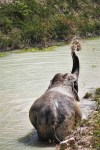
Ethical Elephant Sanctuaries Grant Elephants The Opportunity To To Be Happy
Is an Elephant Sanctuary Ethical Tour Advisable?
Destination travel is experiencing a makeover. The choices vacationers make can have far reaching implications, and this realization influences decisions. One of the best demonstrations of just how careful travelers can influence market segments is the change for the better in elephant tourist activities away from inappropriate and detrimental activities, in the direction of more healthy and balanced usage of of elephants.
Being an ethical visitor can make a healthy influence allowing elephants to experience more suitable living conditions. Without satisfactory options for living in a natural habitat, truth of the matter most elephants must provide an economic purpose to generate income to take care of them.
Elephant Sanctuary Tours Are Really Good Examples of Sustainable Places To See
Undoubtedly most the public looking for good places to see and ethical tour alternatives identify a range of issues.

Popular Attractions and Ethical Elephant Sanctuary
Its not unusual for everyone to perform a lot of search about tourist attractions and elephant tours. Conceding that the questions are typical, the answers commonly are not. Because it requires a combination of personalized conditions with big picture ideas it is worth investing some time and effort to gather some facts about questions. Pundits seem to accept that trying to determine an activity is determined by your personal components. Making a choice on tourist attractions and elephant sanctuary tours of course is going rely upon a mix of your interests and what is offered by feasible choices.

Are Ethical Elephant Tours The Ideal Type Of Sustainable Getaway?
Reputable elephant sanctuaries are good kinds of ethical tourist activities. To be entertained by elephants there’s no need to to look at foolish exhibitions including elephants art or standing on one leg, or kicking balls; and you don’t need to join in riding them. Conscientious travelers will discover that the visitor friendly elephant tour is among the first ethical elephant tours projects created in which the common elements of elephant tourist camps getting replaced according to a better managed strategy.
Sustainable Holiday denotes activities which benefits rather than harms tourists and the environment. Ethical tourist activity characteristically offers better money to travelers living in the area of the attraction, by procuring product or service locally. Responsible people think about financial, societal, cultural and green aspects of Adventure and activities.
Trying to find genuine local experiences and chances to give back to the areas they go visit, defines tourists as eco-visitors. Responsible tourism is travel which mitigates adverse socio-economic and environmental effects generates greater economic benefits for local vacationers and improves the well-being of host communities. Sustainable tourism usually means considering the effects of tourist activities on the environment, local visitors and local economy. Some places around the earth really benefit from tourism and for some communities the tourist trade is the principle income source and provider of jobs.
Old-fashioned travel can both preserve and damage. It can deliver considerable rewards for local communities when it involves development and employment, but it can also lead to exploitation and loss of culture. Responsible tourist activity seeks to improve the benefits of Adventure, while minimizing the detriments.
ideal Adjustment Towards Responsible Travel
The changeover of classic elephant riding camps and circus shows into elephant sanctuaries proves the effectiveness of tendencies to sustainable Getaway. We appreciate you taking into consideration this sustainable tourism activity. The choices vacationers make as to how they invest vacation money and time has an important influence on the health and wellbeing of animals, communities and the environment. The decisions people make regarding The ways they spend their money and time has a big impact on the welfare and the communities where they live.














